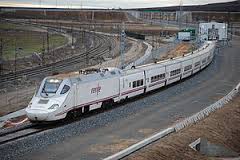 Only China has a more extensive high-speed train network than Spain. On Wednesday night at least 80 people were killed when a high-speed train, rounding a curve, flew off the rails in Santiago de Compostela, Spain. Reuters reports:
Only China has a more extensive high-speed train network than Spain. On Wednesday night at least 80 people were killed when a high-speed train, rounding a curve, flew off the rails in Santiago de Compostela, Spain. Reuters reports:
El Pais newspaper said the driver told the railway station by radio after being trapped in his cabin that the train entered the bend at 190 kilometers per hour (120 mph). An official source said the speed limit on that stretch of twin track, laid in 2011, was 80 kph.
The driver, Francisco Jose Garzon, was reported as saying:
“We’re only human! We’re only human! … I hope there are no dead, because this will weigh on my conscience.”
Oh yes, your precious conscience. Never mind all the corpses and the suffering of the wounded and the families of the dead. If you need a shoulder to cry on, why not give Francesco Schettino, the captain who’s on trial for wrecking the cruise ship the Costa Concordia , a call? What’s a little human error between friends?
Meanwhile (Reuters again):
Investigators were trying to find out why the train was going so fast and why security devices to keep speed within permitted limits had not slowed the train.
Some light was shed on that at euronews. Turns out this particular train was not high-speed per se, but “just” classified high performance.
Beatriz Beiras, euronews: “How is that different from a high speed train?”
Ricard Riol, civil engineer: “Basically it has a maximum speed less than an AVE high-speed train, up to 250 kilometres an hour and it can run on high-speed lines and on conventional tracks.”
euronews: “How could the train go into that particular section of track, so close to the station at Compostela, at 190 kilometres an hour [nearly 120 mph – RW]?”
Ricard Riol: “Generally that’s not possible on a high-speed line, such as Madrid-Barcelona or Madrid-Seville. But on that line it happens that trains entering Santiago de Compostela are not monitored permanently by the signalling system, they are only occasionally checked.”
euronews: “Is the system automatic?”
Ricard Riol: “It is an automatic system which only checks the train when it passes a detector on the track, whereas on a high speed line the system is controlled continuously from a central position via radio, so that the train is never going faster than the authorised speed. … this curve is not protected by a system of continuous signalling, which monitors the train all the time, but only with occasional monitoring on the track.”
In the end of course, Garzon’s precious conscience aside, no high-speed train driver should be forced to work with the knowledge that one mistake on his part — nodding off or whatever — could results in the deaths of dozens.
